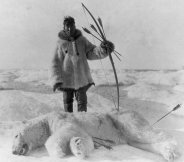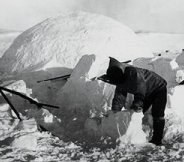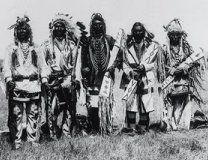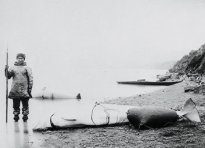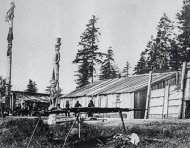The Anthropology Tutorials website will be taken offline on January 9, 2026.
Due to federal accessibility requirements taking effect in 2026, we will be removing this site. If you use materials from this site in your courses or research, please seek alternative resources.
Foraging
Foraging
for wild plants and hunting wild animals is the most ancient of human
subsistence patterns. Prior to 10,000 years ago, all people lived in
this way. Hunting and gathering continued to be the subsistence pattern
of some societies well into the 20th century, especially in environmentally
marginal areas that were unsuited to farming or herding, such as dense
tropical forests, deserts, and subarctic tundra
 .
Earlier foragers also occupied productive river valleys in temperate zones
until these areas became farmlands during the last 5,000-8,000 years.
.
Earlier foragers also occupied productive river valleys in temperate zones
until these areas became farmlands during the last 5,000-8,000 years.
Foragers
generally have a passive dependence on what the environment contains. They do not
plant crops and the only domesticated animals that they usually have are
dogs. These useful animals often have multiple functions for foraging
peoples. They serve as pets, hunting aids, watch-animals, camp refuse scavengers, and
even surplus food when needed.
Some foragers in East Africa and Western North America
are known to have
periodically regenerated the productivity of their environments by
intentionally burning grasslands and sparse woodlands. This encouraged the growth of
tender new vegetation which attracted game animals. It is likely that
controlled burns of this sort were used by foragers elsewhere in the world as
well.
Foragers
rely mainly on their own muscle power in carrying out their
subsistence tasks. Most labor is done individually or in small groups of
relatives and friends. There is an almost a complete absence of
occupational choice. Every man is primarily a hunter of animals and
every woman is mainly a gatherer of plants. Economic roles are mostly
based on gender and age. However, it is not unusual for some tasks to be
performed by either men or women. Gathering of firewood as well as
collecting mollusks, insects, and other small game for food are often non-gender
specific activities.
Most foraging
societies do not establish permanent year-round settlements. Rather, they have
relatively temporary encampments with tents, brush huts, or other easily constructed
dwellings. The length of time that they stay in
any one location is largely determined by the availability of food and
water that is readily obtainable.
In regions that experience seasonal variations in climate, foragers usually
carry out a round of migrations determined by the resources that can
be exploited at particular times of the year in different areas of their
territories. In this way, they increase the amount of food and can
support somewhat larger populations than otherwise. However, their
migrations are limited by the fact that most foraging societies travel on
foot.
Foraging
population
densities are very low compared to other subsistence patterns. In harsh,
relatively unproductive environments, densities of
foragers have been as low as one person per 10-50 square miles. In rich
environments, the densities have been as high as 10-30 people per square mile. The optimal community
size usually is about 25-30 people, depending on the availability of food
and water. However, the band
 size tends to stabilize well below the
carrying capacity of the local environment. Social factors rather than
food scarcity usually limit the community size. With increased numbers
of people, there is increased potential for social conflict. The result
is a splitting of the band. Fissioning of the community into two bands
that go their own way has the effect of preventing a large population
concentration that could strain the carrying capacity of the environment.
size tends to stabilize well below the
carrying capacity of the local environment. Social factors rather than
food scarcity usually limit the community size. With increased numbers
of people, there is increased potential for social conflict. The result
is a splitting of the band. Fissioning of the community into two bands
that go their own way has the effect of preventing a large population
concentration that could strain the carrying capacity of the environment.
Anthropologists
have identified three major variations of the foraging subsistence pattern:
| 1. |
pedestrian
 (diversified hunting and gathering on foot)
(diversified hunting and gathering on foot) |
| 2. |
equestrian
 (concentrating on hunting large mammals from horseback)
(concentrating on hunting large mammals from horseback) |
| 3. |
aquatic
 (concentrating on fish and/or marine mammal hunting usually from boats)
(concentrating on fish and/or marine mammal hunting usually from boats) |
Equestrian and
aquatic foragers have specialized subsistence patterns. They focus
their food getting efforts on a limited range of species. This allows
them to become very efficient at harvesting them. As a result, they
usually have abundant food supplies and larger communities than pedestrian
foragers. However,
there is a downside to a specialized subsistence pattern. It can be a
precarious way of life in a changing environment. An epidemic
 or
other catastrophic event can rapidly reduce the numbers of animals
that are the focus of the hunt. In contrast, the diversified subsistence approach of
most pedestrian foragers has the advantage of relative economic security if
there are fluctuations in the weather, water supply, or periodic die-offs of
the food sources. The disadvantage of a diversified subsistence
pattern is that the total amount of food calories acquired is often less and
the amount of time required to secure them is greater.
or
other catastrophic event can rapidly reduce the numbers of animals
that are the focus of the hunt. In contrast, the diversified subsistence approach of
most pedestrian foragers has the advantage of relative economic security if
there are fluctuations in the weather, water supply, or periodic die-offs of
the food sources. The disadvantage of a diversified subsistence
pattern is that the total amount of food calories acquired is often less and
the amount of time required to secure them is greater.
Pedestrian Foraging
The
general foraging way of life described above mostly fits the
pedestrian pattern. This has been the commonest form of hunting and
gathering.
At one time, pedestrian foragers lived on all continents except Antarctica. Prior to the
invention of agriculture around 10,000 years ago, almost all people lived in this
way. They occupied the rich fertile valleys, hills, and
grasslands. By the early 20th century, however, this subsistence pattern
survived only in marginal areas that farmers and herders were not able to or
interested in exploiting. The most well known pedestrian foragers were
the Australian Aborigines, the San
 speakers of Southwest Africa, the
pygmies
speakers of Southwest Africa, the
pygmies
 of West Central Africa, most California Indians, and the Paiutes
of West Central Africa, most California Indians, and the Paiutes
 of the Great Basin
in Western North America. Other pedestrian foragers lived in marginal
areas of Asia, Africa, and the Americas.
Surviving
pedestrian foragers have been heavily impacted by large-scale agricultural
societies. Few if any of these foragers are still following their old
subsistence pattern exclusively.
of the Great Basin
in Western North America. Other pedestrian foragers lived in marginal
areas of Asia, Africa, and the Americas.
Surviving
pedestrian foragers have been heavily impacted by large-scale agricultural
societies. Few if any of these foragers are still following their old
subsistence pattern exclusively.
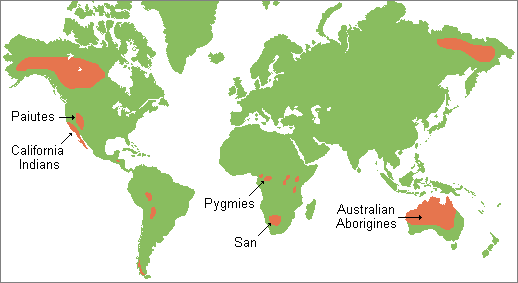 |
| Pedestrian
foragers during the late 19th century |
The
pedestrian hunting and gathering way of life was highly mobile. Most of
these societies moved their camps several times a year and had temporary
dwellings. The number of people living in a camp also often varied
throughout the year depending on the local food supply. Material
possessions were generally few and light in weight so that they could be
transported easily. Subsistence tools included such things as simple
digging sticks, baskets, spears, and bows and arrows that could be easily replaced when
needed. This settlement flexibility is an efficient way of responding to
changing environmental opportunities.
Equestrian
Foraging
| |
 |
|
Equestrian foragers |
Equestrian foragers
have evolved in only two areas of the world--the Great Plains of North America
and the sparse grasslands of Southern Argentina. In both cases, pedestrian foragers acquired
horses from Spanish settlers in the early 17th century. Over several generations, horse breeding
and riding skills were honed. This resulted in a revolutionary change in
these Native American societies. The horse became the principle mode of
transportation and dramatically increased hunting success in the pursuit of
big animals. These societies became larger, more mobile, and were now
able to travel over larger areas throughout the year. Horses allowed
them to effectively follow the seasonal migrations of large herbivores over
hundreds of miles. In North America the prey of choice for the Sioux
 ,
Crow
,
Crow
 ,
Cheyenne
,
Cheyenne
 , and others was the bison
or buffalo. In South America, the guanaco
, and others was the bison
or buffalo. In South America, the guanaco
 was hunted by the Tehuelche
was hunted by the Tehuelche
 .
Guanacos are camelids related to the domesticated llamas, alpacas, and
vicuas.
.
Guanacos are camelids related to the domesticated llamas, alpacas, and
vicuas.
|
 |
|
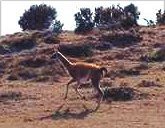 |
|
North American bison |
|
South American guanaco |
The
equestrian foraging societies became male dominated and warlike. This was
particularly true on the Great Plains of North America after the widespread acquisition
of guns in the 19th century. Raiding other
societies to steal horses and defeat enemy warriors was the principle path to
respect and success for men. Their societies acquired hierarchical
 ,
almost military-like forms of political organization with chiefs at the
top. In contrast, pedestrian foragers are comparatively peaceful and
have very democratic political systems that usually lack fulltime leaders.
,
almost military-like forms of political organization with chiefs at the
top. In contrast, pedestrian foragers are comparatively peaceful and
have very democratic political systems that usually lack fulltime leaders.
The
combination of aggressiveness and high mobility made it very difficult for the
U.S. and Argentine armies to subdue the equestrian foragers during the last
half of the 19th century. In both countries, it required a number of
army regiments
with rapid fire guns and light artillery. In the case of the North
American Plains Indians, decimation of the bison herds at that time by
non-Indian hunters was the most important factor in subduing them because it
destroyed their traditional subsistence base. All equestrian foragers were forced to
move from their homelands to relatively small isolated reservations.
Today, their survivors are mostly living in poverty with little hope for their
future.
Aquatic
Foraging
|
|
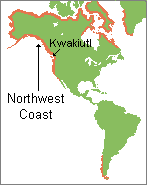 |
Aquatic
foragers
of the Americas |
Aquatic
foragers focus their subsistence activities on fish, mollusks, crustaceans, and/or marine
mammals. The most well known aquatic foragers lived on the Northwest Coast of North
America from the Klamath River of California to the Aleutian Islands of
Alaska. These societies specialized mostly in salmon fishing along the rivers and
hunting seals and whales off the coast. Other aquatic foragers
occupied the coastal regions of the American subarctic, the Channel Islands of Southern California, the southern tip of South
America, the coastal areas of Eastern Siberia, and a few other regions of the
world.
The
exploitation of fish and other marine resources is usually a far more reliable and
productive form of foraging than the diversified hunting and gathering of most
foragers who live away from the coasts and major rivers. Among
the Northwest Coast Indians, settlements were usually
permanent. On Vancouver Island in Western Canada, the Kwakiutl
 and some
of their neighbors built split plank wood homes and large community halls for
ritual performances, dances, and feasts. They had the leisure time to invest considerable
effort in creating elaborate clothing, masks, and large wood carvings (e.g.,
totem poles
and some
of their neighbors built split plank wood homes and large community halls for
ritual performances, dances, and feasts. They had the leisure time to invest considerable
effort in creating elaborate clothing, masks, and large wood carvings (e.g.,
totem poles
 and boxes). They also had relatively complex social stratification for
foraging peoples. Politically powerful men had titles and privileges
reminiscent of Medieval European lords.
and boxes). They also had relatively complex social stratification for
foraging peoples. Politically powerful men had titles and privileges
reminiscent of Medieval European lords.
Today,
many aquatic foraging societies continue exploiting marine resources but as
part of the international economy. They fish commercially with well
equipped modern
boats and sell most of their catch to buy things that they do
not produce themselves. Apparently, no aquatic foragers
still solely practice their traditional subsistence patterns.
Misconceptions
about Foraging
The
most common image of the hunting and gathering way of life until recently was
that of an uncertain existence in a harsh environment and a short miserable
life. This view was more of an ethnocentric projection than an accurate
description of the lives of foragers. It was based on our tendency to pigeonhole human societies
in terms of an outdated evolutionary framework. It was assumed that if
the technology is simple then life must be grim. It was a vestige of the
Victorian belief that our "civilized" lives are not only more
efficient but also more comfortable than those of "primitive"
peoples.
Ethnographic
research carried out over the last half century has largely demolished this
myth that foragers in the past had to struggle for existence. In fact,
they usually had a food supply that was adequate and reliable. Most of
them only had to expend minimal labor to provide for their basic needs.
What is particularly surprising to people in industrialized nations is that foragers often lived
well into old age with few signs of anxiety and insecurity.
Outside
of the subarctic
 , most foragers subsisted mainly on nuts,
vegetables, fruits, and even protein rich insects. Hunting large animals
was relatively unreliable. Among the San speakers of the Kalahari
, most foragers subsisted mainly on nuts,
vegetables, fruits, and even protein rich insects. Hunting large animals
was relatively unreliable. Among the San speakers of the Kalahari
 Desert in Namibia and Botswana,
60-80% of the diet came from non-meat sources, especially nuts and
roots. Since women provided most of the vegetable foods, they were
responsible for the majority of the calories that were consumed. Men
mostly provided the most desirable food, which was meat. The San way of
life was remarkably efficient. While they had few days that were free of
subsistence activities, the ratio of labor expenditure to production was
low. The ethnographer Richard Lee discovered that adult San spent only about 2 days of 6 hours each week hunting and
gathering. Young people did not fully join the work force until around 20
years old. The 60% of the society that were healthy adults, provided
the food for everyone by working only 15 hours a week. Foragers have rightly been referred to
by Richard Lee as the most leisured people.
In the United States today, less than 1% of the population produces all of the
food for the entire society. Given this remarkable efficiency, it is
worth asking why the rest of us work 40-50 hours a week, often with
considerable psychological stress.
Desert in Namibia and Botswana,
60-80% of the diet came from non-meat sources, especially nuts and
roots. Since women provided most of the vegetable foods, they were
responsible for the majority of the calories that were consumed. Men
mostly provided the most desirable food, which was meat. The San way of
life was remarkably efficient. While they had few days that were free of
subsistence activities, the ratio of labor expenditure to production was
low. The ethnographer Richard Lee discovered that adult San spent only about 2 days of 6 hours each week hunting and
gathering. Young people did not fully join the work force until around 20
years old. The 60% of the society that were healthy adults, provided
the food for everyone by working only 15 hours a week. Foragers have rightly been referred to
by Richard Lee as the most leisured people.
In the United States today, less than 1% of the population produces all of the
food for the entire society. Given this remarkable efficiency, it is
worth asking why the rest of us work 40-50 hours a week, often with
considerable psychological stress.
Foragers
often have long lives compared
to people in the industrial societies of the 19th and early 20th centuries. Richard Lee discovered that 10% of the San were over 60 years of
age and the elderly, blind, senile, and crippled were supported by
their families. In the United States today, 10-15% of the people are
over 60 and life expectancy is in the low to mid 70's. However, living
to an advanced age in the Western World is a very recent trend primarily resulting from modern medicine. In 1900, the
average life expectancy in the United States was only 50. At the time of
the American Revolution, it was 35. By comparison, the San lived
relatively long, healthy lives.
Note:
The most well known San speakers of southern Africa are the !Kung or Ju/'hoansi
 .
They maintained their traditional foraging way of life into the 1960's.
Since then, they have been increasingly forced into smaller territories that
are not adequate to support their population by foraging. Today, most of them
are poor subsistence farmers in Namibia. In 2002, the government of
Botswana drove their surviving San foragers out of the Central Kalahari
Desert because they continued to hunt in what was declared a game reserve.
In 2004, a delegation of these San went to Washington D.C., the World Bank,
and the United Nations to plead for help. They were hoping that world
public opinion would force Botswana to allow them to return to what has been
their homeland probably for the last 20,000 years. Few have paid heed
to their appeal.
.
They maintained their traditional foraging way of life into the 1960's.
Since then, they have been increasingly forced into smaller territories that
are not adequate to support their population by foraging. Today, most of them
are poor subsistence farmers in Namibia. In 2002, the government of
Botswana drove their surviving San foragers out of the Central Kalahari
Desert because they continued to hunt in what was declared a game reserve.
In 2004, a delegation of these San went to Washington D.C., the World Bank,
and the United Nations to plead for help. They were hoping that world
public opinion would force Botswana to allow them to return to what has been
their homeland probably for the last 20,000 years. Few have paid heed
to their appeal.
This page was last updated on
Monday, October 30, 2006.
Copyright 2001-2006 by Dennis
O'Neil.
All rights reserved.
Illustration credits
![]() .
Earlier foragers also occupied productive river valleys in temperate zones
until these areas became farmlands during the last 5,000-8,000 years.
.
Earlier foragers also occupied productive river valleys in temperate zones
until these areas became farmlands during the last 5,000-8,000 years.
